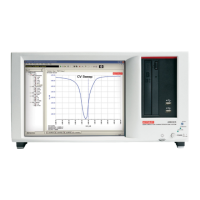4200-900-01 Rev. K / February 2017 Return to Section Topics 2-7
Model 4200-SCS User’s Manual Section 2: Model 4200-SCS Software Environment
Project defined
Users interact with KITE in the context of project. A project specifies the start-to-finish, repetitive
and nonrepetitive actions and test locations involved in evaluating a semiconductor wafer (or other
collection of circuits). Projects are both created and executed using the KITE GUI.
NOTE Refer to Project plan later in this section. The term “project” is sometimes used to
refer to a “project plan.”
Project components
Because KITE is most valuable for automatic characterization of semiconductor wafers, KITE
projects are organized in a manner consistent with the organization of a modern semiconductor
wafer. A project visits and evaluates locations on the wafer in the following logical hierarchy:
•Project
• Sites (Virtual, can be switched using the Sites Navigator)
• Subsites
• Devices
• Tests
These are the primary components of a project. Two other components, initialization steps and
termination steps, are discussed in the Reference Manual, Project structure, page 6-39. These
components are defined in the next subsections.
Sites
At the macroscopic level, one or more semiconductor dies are built up at a given wafer location.
This location is comprised not only of end product dies, but usually has one or more parametric
test structures or subsites. KITE refers to such a repeating pattern of dies and test structures as a
“site.”
NOTE In KITE, sites can be switched using the site navigator. All KITE sites have the same
subsite, device, and test definitions, and are not repeated in the Project Tree.
Subsites
The terminals of each device on a test structure are connected to a uniformly-spaced series of
contact pads. These pads are used to connect the devices to the probes of a prober. Any single
wafer location that the prober moves to and contacts is called a “subsite” (sometimes referred to
as a test element group (TEG)).
The Model 4200-SCS hardware / KITE software combination was optimized to evaluate test
structures, though it can be effectively used to evaluate dies and discrete components. KITE refers
to each such test structure (or combination of test devices that are tested as a group) as a subsite.
Devices
As described in context under Sites, each test structure contains a series of devices to be
characterized: Transistors, diodes, resistors, capacitors, and so on. A switch matrix is used to
connect the Model 4200-SCS sequentially if the SMUs cannot be connected to all devices
simultaneously.
A “device” is also referred to as a test element, because subsites are often referred to as test
structures or test element groups (TEGs), which are composed of devices.

